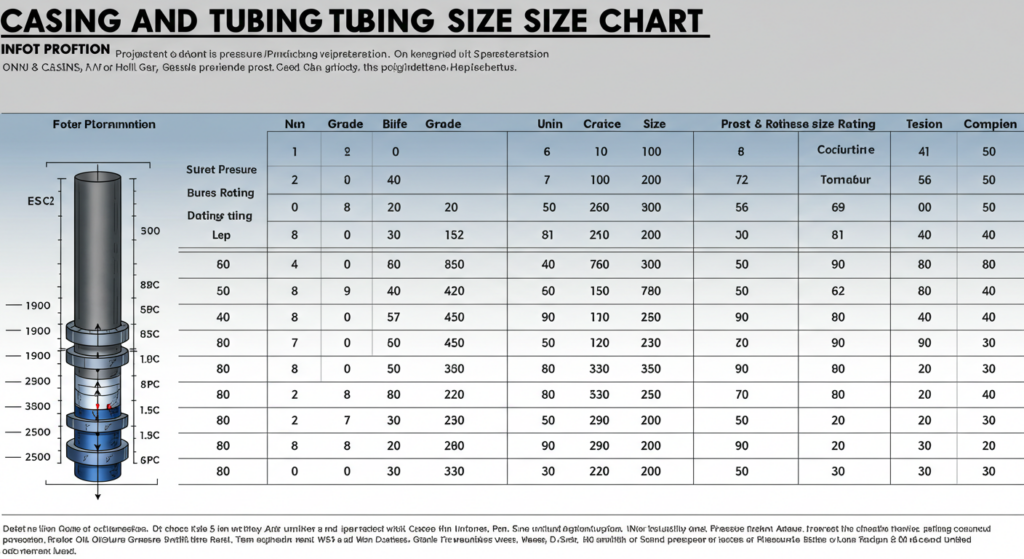Introduction: Understanding Pressure Ratings in Oil & Gas Wells
In the complex world of oil and gas extraction, casing and tubing pressure ratings stand as critical factors that can determine the success or failure of a drilling operation. These specialized pipes form the backbone of any well, with each component designed to withstand specific pressure conditions while performing distinct functions.
This comprehensive guide explores everything you need to know about casing and tubing size charts, pressure ratings, and how to select the right components for your specific well conditions. Whether you’re a seasoned petroleum engineer or new to the industry, understanding these fundamental elements will help ensure safer, more efficient, and more productive drilling operations.
Casing vs. Tubing: Essential Components with Different Purposes
Before diving into pressure ratings and size charts, let’s clarify the fundamental differences between these two critical wellbore components:
Casing: The Structural Foundation
Casing serves as the structural backbone of the well, with multiple critical functions:
- Prevents wellbore collapse by supporting the walls
- Protects freshwater zones from contamination
- Isolates different pressure zones within the formation
- Provides a foundation for wellhead equipment
- Creates a controlled environment for drilling operations
Tubing: The Production Pathway
Tubing focuses on the production aspect of the well:
- Creates a conduit for oil and gas to flow from the reservoir to the surface
- Enables controlled production rates
- Facilitates well interventions and maintenance operations
- Isolates production fluids from the casing
- Optimizes flow dynamics during production
Why Pressure Ratings Matter in Casing and Tubing Selection
Pressure ratings aren’t just technical specifications—they’re critical safety factors that determine whether your well components can withstand the forces they’ll encounter throughout the well’s lifecycle.
| Component Type | Typical Pressure Range (psi) | Key Pressure Considerations |
| Casing | 1,500 – 10,000 | External collapse pressure, burst pressure, tension |
| Tubing | 2,000 – 15,000 | Internal pressure, collapse pressure, temperature effects |
Operating beyond these pressure limits can lead to catastrophic failures, including:
- Well collapse
- Environmental contamination
- Loss of production
- Safety hazards for personnel
- Costly remediation work
Comprehensive Casing Pressure Ratings and Specifications
Factors That Influence Casing Pressure Requirements
Multiple variables affect the pressure that casing must withstand:
- Well Depth: Deeper wells create higher hydrostatic pressure conditions
- Formation Pressure: Varying pressure zones throughout the well depth
- Drilling Fluid Weight: Heavier muds create higher internal pressures
- Temperature Gradients: Heat can affect material strength and pressure resistance
- Formation Characteristics: Unstable formations may exert additional external pressure
Standard Casing Pressure Rating Chart
Below is a comprehensive reference chart for common casing sizes and their corresponding pressure ratings:
| Casing Size (inches) | Wall Thickness (inches) | Weight (lb/ft) | Pressure Rating (psi) |
| 4.5 | 0.205 | 11.6 | 10,000 |
| 5.5 | 0.275 | 17.0 | 8,200 |
| 7.0 | 0.317 | 26.0 | 6,400 |
| 9.625 | 0.395 | 43.5 | 3,600 |
| 10.75 | 0.350 | 45.5 | 1,300 |
| 13.375 | 0.480 | 72.0 | 2,730 |
| 16.0 | 0.438 | 84.0 | 1,600 |
| 20.0 | 0.438 | 106.5 | 1,000 |
Note: Pressure ratings may vary based on grade, connection type, and manufacturer specifications.
Detailed Tubing Pressure Ratings and Specifications
Critical Factors Affecting Tubing Pressure Capacity
Tubing pressure capacity is influenced by several key factors:
- Material Grade: Higher-grade materials offer increased pressure resistance
- Wall Thickness: Thicker walls generally provide higher pressure ratings
- Diameter: Smaller diameters typically withstand higher pressures
- Connection Type: Premium connections may offer enhanced pressure capabilities
- Operating Temperature: Extreme temperatures can reduce pressure capacity
Comprehensive Tubing Pressure Rating Chart
Reference this detailed chart when selecting tubing for your well requirements:
| Tubing Size (inches) | Wall Thickness (inches) | Weight (lb/ft) | Grade | Pressure Rating (psi) |
| 1.900 | 0.145 | 2.90 | J-55 | 8,700 |
| 2.375 | 0.154 | 4.70 | J-55 | 5,000 |
| 2.375 | 0.190 | 5.80 | L-80 | 7,900 |
| 2.875 | 0.203 | 6.50 | J-55 | 5,100 |
| 2.875 | 0.217 | 7.90 | L-80 | 7,700 |
| 3.500 | 0.216 | 9.30 | J-55 | 4,500 |
| 3.500 | 0.254 | 10.20 | P-110 | 9,500 |
| 4.500 | 0.250 | 11.60 | J-55 | 4,000 |
| 4.500 | 0.337 | 15.10 | P-110 | 8,000 |
Note: Always consult manufacturer specifications for exact pressure ratings under specific well conditions.
Selecting the Right Casing and Tubing: Size and Pressure Considerations
Matching Components to Well Requirements
The selection process for casing and tubing involves careful analysis of several factors:
Well Depth Considerations
| Well Depth (ft) | Recommended Casing | Recommended Tubing |
| 0-3,000 | Lower pressure rating sufficient | Standard J-55 grade |
| 3,000-8,000 | Medium pressure rating | J-55 or L-80 depending on conditions |
| 8,000-12,000 | High pressure rating | L-80 or P-110 |
| 12,000+ | Premium high-pressure casing | P-110 or specialized alloys |
Formation Pressure Management
| Formation Pressure | Casing Recommendation | Tubing Recommendation |
| Normal Pressure | Standard pressure rating | Standard J-55 or L-80 |
| High Pressure | Enhanced pressure rating, thicker wall | L-80 or P-110 |
| Abnormal Pressure | Premium connections, specialized grades | Premium connections, P-110 or specialized |
Pressure Testing and Safety Factors
When implementing casing and tubing, standard industry practice includes:
- Testing to 1.25-1.5 times the expected maximum working pressure
- Incorporating a safety factor of at least 1.1 for collapse pressure
- Including a safety factor of 1.25 for burst pressure
- Accounting for temperature effects on pressure ratings (typically 10% reduction for every 100°F increase)
Material Selection for Different Pressure Environments
Strength Comparison by Material Type
| Material Type | Yield Strength (psi) | Tensile Strength (psi) | Best Application |
| J-55 | 55,000 | 75,000 | Standard pressure environments |
| K-55 | 55,000 | 95,000 | Medium pressure, better corrosion resistance |
| N-80 | 80,000 | 100,000 | Higher pressure applications |
| L-80 | 80,000 | 95,000 | Corrosion-resistant high-pressure applications |
| P-110 | 110,000 | 125,000 | High-pressure, deep well applications |
| Q-125 | 125,000 | 135,000 | Extremely high-pressure environments |
Material Suitability for Challenging Well Conditions
| Well Condition | Recommended Material | Special Considerations |
| High H₂S Content | L-80, Chrome alloys | Must meet NACE MR0175 standards |
| High CO₂ Content | 13Cr, Duplex stainless | Enhanced corrosion resistance needed |
| High Temperature | L-80, P-110 | Temperature de-rating must be applied |
| Arctic Conditions | Special low-temp steel | Impact resistance testing required |
| Deep Offshore | Premium high-strength | Combined pressure and tension resistance |
Cost-Benefit Analysis: Balancing Pressure Ratings and Budget
When selecting casing and tubing, consider these economic factors:
- Initial Investment vs. Long-Term Value
- Higher-grade materials cost more initially but may prevent costly failures
- Premium connections add cost but provide enhanced pressure integrity
- Risk Assessment Considerations
- Higher pressure environments justify additional investment in premium products
- Well remediation after a pressure-related failure typically costs many times more than using appropriate pressure-rated components initially
- Optimization Strategies
- Use higher-grade materials only in zones with challenging pressure conditions
- Consider tapered string designs with varying pressure ratings at different depths
Conclusion: Making Informed Decisions Based on Pressure Requirements
Understanding casing and tubing size charts and their corresponding pressure ratings is fundamental to successful oil and gas operations. By carefully analyzing well conditions and selecting components with appropriate pressure capabilities, operators can:
- Enhance safety for personnel and the environment
- Extend the productive life of the well
- Reduce the risk of costly failures
- Optimize production capabilities
- Ensure regulatory compliance
Remember that pressure ratings aren’t just numbers on a specification sheet—they represent the boundary between safe operations and potential disaster. Take the time to properly analyze your well’s pressure profile and select casing and tubing components that provide adequate safety margins for your specific conditions.



